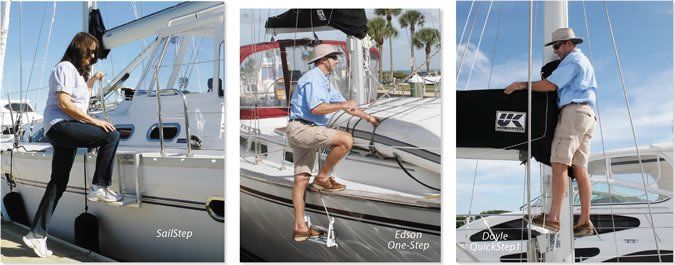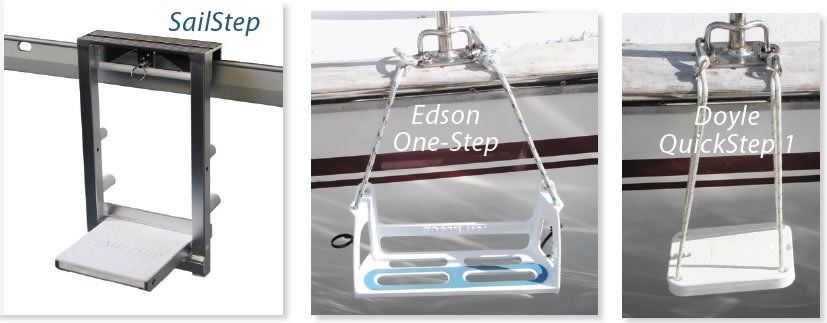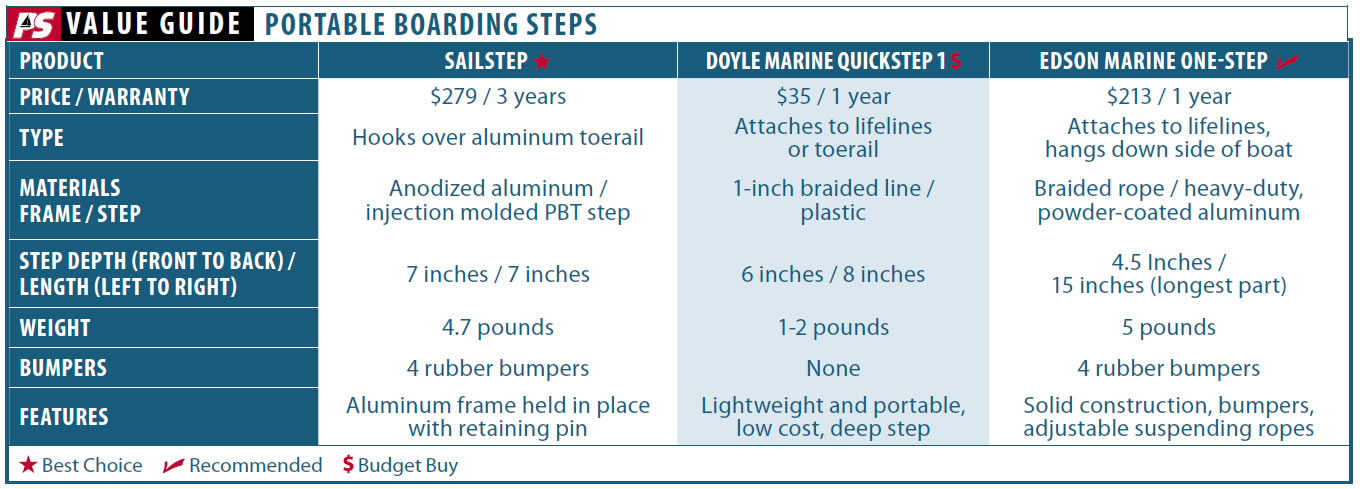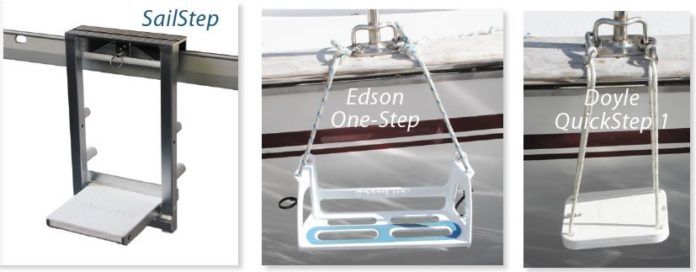Anyone thats ever hopped on a Jacobs ladder at a fall festival can relate to the feeling of the rope-attached steps swaying wildly from side to side under your weight. Suspended boat-boarding steps can inspire that same unsteady feeling. Ascending the steps, which curve in along the chines of a boat, can throw a climbers center of gravity backward, away from the hull-possibly sending the climber into the drink.

In search of a safe and easy way to board a boat from the dock or a dinghy, we compared three single-step, portable boarding steps from SailStep, Doyle Marine, and Edson Marine. The three are designed to either hang from lifelines near stanchions or to be hooked over a toerail.
How We Tested
Portable boarding steps make it easier to get on and off a boat with high freeboard, dividing the distance between the dock and deck (or dinghy) for the little legs of young crew and the flexibility-challenged legs of older or injured sailors. Some can also be used in other applications, like an added boost at the mast or a step up to the bow when casting off a dock.
Testers looked at the safety features and pros/cons of the three products. We evaluated construction quality and materials, durability, ease of stowage, ease of use, and versatility.
For ease of use ratings, testers put the boarding steps to work in various applications (deck and dinghy boarding, mast work, etc.) on three different boats, with and without angled hulls.
Based on guidelines from the Occupational Safety and Health Administration (OSHA) and our own experiences, we consider an ideal distance between boarding steps to be 8 to 10 inches when the steps are likely to get wet. Step width should be 16 inches, according to OSHA, but on a single-step boarding ladder, which supports one foot at a time, we find 7 to 12 inches to be a good size. Toe clearance may be an even more important factor: OSHA requires 6 inches-and we agree-and certainly anything less than 4.5 inches isn’t acceptable.

Doyle QuickStep1
Doyle Marines QuickStep1 is a wide, plastic step that offers plenty of stepping space for most feet, but its not so wide that its difficult to center your weight on the step. The step is a 6-by-8-inch plastic platform, suspended from 1-inch-diameter braided lines and hung from lifelines with snap shackles. The keep-it-simple design has no pins to keep up with, no bumpers, no handles, no frame or screws, and it weighs less than 2 pounds.
Lightweight and easy to grab, move, and secure, the height-adjustable QuickStep1 is suggested for use while boarding, but it could be used for a slight step up at the mast (allowing you to reach the top of your sail covers), or to get into the dinghy from the water.
While its not as rugged as the other steps in the test, the plastic QuickStep1 can be submerged without corrosion concerns, and the compact step is easy to store and very portable.
Testers liked the deep step, which offered easy and steady footing, but sudden weight shifts will have you swinging on the bumper-less platform. Use does require adequate upper-body strength.
Doyle also makes the two-step QuickStep2, which is more like a ladder; it retails for $43.
Bottom line: The QuickStep1 offers more versatility than the others we tested, and for $35, its a good option for those looking for a step that can be used in more ways than simply as a boarding step. Its a good fit if you need a step for children, but its not ideal for older sailors who need locked-in stability. The design also makes an easy do-it-yourself project, but youd likely end up spending more on materials than $35. Its the PS Budget Buy.
Edson One-Step
Made of corrosion-resistant aluminum powder-coated with a durable white urethane, Edson Marines One-Step boarding step is designed to attach to lifeline gate stanchions and hang against the side of the boat. It has four neoprene bumpers that help steady the step and help protect the topsides from scuff marks. The single step is suspended by an adjustable 6 feet of braided line with stainless snap shackles.
While the 4 inch-by-15 inch aluminum step takes up less stowage space than a hanging ladder, it has some heft to it and requires two hands to set. Its bulletproof construction suggests it will last well beyond its one-year warranty.
Testers noted that it was hard to find a comfortable center of gravity when first setting foot on the step; this was attributed to the steps framed in back, which creates a sort of open box shape, and the shallow step (4.5 inches). Users had a tendency to step on the frames outer edge because of the skinny step and the backing, and concentrating body weight in this way-while pulling yourself up using the rope or stanchion-makes the step lean away from the boat, placing the load on the shackles and stanchions, and shifting the users center of gravity backward.
Bottom line: The One-Steps biggest advantage is its heavy-duty construction. While we prefer a deeper step, the One-Step will appeal to agile boat owners who like its ruggedness and are looking solely for a boarding step. We Recommend it for the traditionalist and those who cannot use the SailStep because they lack an aluminum toerail.
SailStep
SailStep designer Clayton Chinn created the SailStep as a stable and safe means for his wife to get on and off the boat while docking and casting off, but we found it to be a secure step for typical boarding as well.
The SailStep, the only step we tested that isn’t suspended using rope, has an anodized-aluminum frame with a hinged, fold-down, nonskid plastic step (roughly 7 inches square); the frames U-shaped top hooks over an aluminum toerail and is secured with a retaining pin. Its adjustable, rubber bumpers keep it from marring gelcoat and help steady the step.
Testers found the step easy to attach and unattach quickly, and it was the most stable in use. Testers noted two major drawbacks of the design: It lacks the versatility of the One-Step as it can only be used on boats with aluminum toerails, and the small retaining pin can be lost overboard. In the wake of our findings, SailStep reported, the maker now sells the kit with a float attached to the retaining pin, and SailStep models that can be attached to fiberglass and wood toerails are in the works.
The SailStep stores flat in a supplied, heavy-duty mesh storage bag and measures 16 inches long by 10 inches wide and 3 inches thick when stored.
Bottom line: Designed by sailors for sailors, the SailStep isn’t cheap at $279, but the impressive frame and solid step are well made and were designed with practical use aboard sailboats in mind. The step comes with a three-year warranty, and its heavy-duty construction should last for years. It gets the Best Choice pick in this trio.
Conclusion
The QuickStep1 is a handy tool to divide the distance between dock and deck for nimble folks and small folk. Its portability, versatility, and low price earn it our Budget Buy pick. Older sailors looking for solid support for creaky knees and stiff hips would not be disappointed with their investment in the SailStep, our Best Choice. If durability and a traditionalist aesthetic are your priority, consider the PS Recommended One-Step.
Keep in mind: Boarding steps should be used as a place to pause your bodyweight, not to bivouac during a blow. They are not a place to ride underway and are not rescue ladders. When ascending, users let their upper body do most of the hauling work. Also, the steps construction and design quality are a non-issue if the attached lifelines, stanchions, and toerails are faulty or loose. Consider bracing attached stanchions to support the lifeline when a gate is open.





































